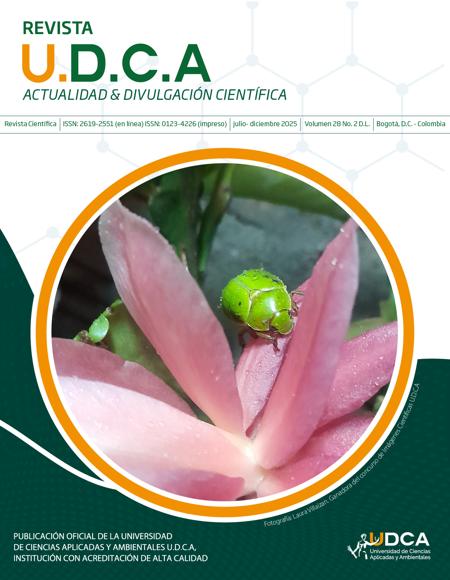Evaluación de técnicas de valorización de la biomasa residual de la producción de tomate dentro de una perspectiva de economía circular
Evaluation of Techniques for the Valorization of Residual Biomass from Tomato Production within a Circular Economy Perspective
Contenido principal del artículo
Resumen
La valorización de la biomasa residual agrícola es una de las principales estrategias potenciales para el alcance de la economía circular en el contexto colombiano. Sin embargo, este proceso debe considerar una visión integral teniendo en cuenta el potencial del residuo. El propósito de este trabajo fue evaluar tres tecnologías para la valorización in situ de residuos resultantes de la producción de tomate fresco, incluyendo biocarbón en sistema de retorta, compostaje y co-compostaje. En una primera fase se caracterizó la biomasa residual de los sistemas de producción de tomate, posteriormente se implementaron las tecnologías y se evaluaron desde un enfoque económico y de ciclo de vida considerando los flujos de materiales, agua, balance energético, costes y tiempo, en términos de unidad funcional de análisis de una tonelada de producto final obtenido. Se determinó que por cada tonelada de tomate fresco producido se generan unos 297.7 kg de residuos orgánicos, por lo que las tecnologías son técnicamente viables. Pero el biocarbón, a pesar de tener el perfil de temperatura esperado para la pirólisis lenta, no es ventajoso a pequeña escala en términos de coste y demanda energética. Sin embargo, la adición de biocarbón al compost aumentó la retención de nitrógeno en un 35%, y demandó menos agua en el proceso manteniendo las características esperadas, lo que influyó en su valorización y llevó a la conclusión de que se pueden encontrar oportunidades en la integración de tecnologías que buscan aumentar el uso de la biomasa de residuos agrícolas, su recirculación y valorización.
Palabras clave:
Descargas
Datos de publicación
Perfil evaluadores/as N/D
Declaraciones de autoría
- Sociedad académica
- Universidad de Ciencias Aplicadas UDCA
- Editorial
- Universidad de Ciencias Aplicadas y Ambientales U.D.C.A
Detalles del artículo
Referencias (VER)
AGYARKO-MINTAH, E.; COWIE, A.; VAN ZWIETEN, L.; SINGH, B.P.; SMILLIE, R.; HARDEN, S.; FORNASIER, F. 2017. Biochar lowers ammonia emission and improves nitrogen retention in poultry litter composting. Waste Management. 61:129-137. https://doi.org/10.1016/j.wasman.2016.12.009
ALCALDÍA MUNICIPAL SUTAMARCHÁN. 2023. Plan de Desarrollo Sutamarchán progresa con sumercé 2020 - 2023. Available from Internet in: https://sutamarchanboyaca.micolombiadigital.gov.co/sites/sutamarchanboyaca/content/files/000338/16869_plan-de-desarrollo-sutamarchan.pdf
ALEGE, F.P.; GU, X.; TAO, H.; MIITO, G.J.; NDEGWA, P.M. 2021. Dairy manure compost pelleting process: A techno-economic analysis. Journal of Cleaner Production. 310:127481. https://doi.org/10.1016/j.jclepro.2021.127481
ALTIKAT, A.; ALMA, M.H.; ALTIKAT, A.; BILGILI, M.E.; ALTIKAT, S. 2024. A comprehensive study of biochar yield and quality concerning pyrolysis conditions: A multifaceted approach. Sustainability. 16(2):937. https://doi.org/10.3390/su16020937
AMALINA, F.; RAZAK, A.S.; KRISHNAN, S.; SULAIMAN, H.; ZULARISAM, A.W.; NASRULLAH, M. 2022. Biochar production techniques utilizing biomass waste-derived materials and environmental applications – A review. Journal of Hazardous Materials Advances. 7:100134. https://doi.org/10.1016/j.hazadv.2022.100134
ANTONANGELO, J.A.; CULMAN, S.; ZHANG, H. 2024. Comparative analysis and prediction of cation exchange capacity via summation: Influence of biochar type and nutrient ratios. Frontiers in Soil Science. 4:1371777. https://doi.org/10.3389/fsoil.2024.1371777
BARZEE, T.J.; EDALATI, A.; EL-MASHAD, H.; WANG, D., SCOW, K.; ZHANG, R. 2019. Digestate biofertilizers support similar or higher tomato yields and quality than mineral fertilizer in a subsurface drip fertigation system. Frontiers in Sustainable Food Systems. 3:00058. https://doi.org/10.3389/fsufs.2019.00058
BOSCHIERO, M.; DE LAURENTIIS, V.; CALDEIRA, C.; SALA, S. 2023. Comparison of organic and conventional cropping systems: A systematic review of life cycle assessment studies. Environmental Impact Assessment Review. 102:107187. https://doi.org/10.1016/j.eiar.2023.107187
BRUNI, C.; AKYOL, C.; CIPOLLETTA, G.; EUSEBI, A.L.; CANIANI, D.; MASI, S.; Colón, J.; FATONE, F. 2020. Decentralized community composting: Past, present and future aspects of Italy. Sustainability. 12(8):3319. https://doi.org/10.3390/SU12083319
DUNLOP, S.; CAMPS ARBESTAIN, M.; BISHOP, P.; WARGENT, J. 2015. Closing the loop: Use of biochar produced from tomato crop green waste as a substrate for soilless, hydroponic tomato production. HortScience. 50(10):1572-1581. https://doi.org/10.21273/HORTSCI.50.10.1572
DUQUE-ACEVEDO, M.; BELMONTE-UREÑA, L.J.; YAKOVLEVA, N.; CAMACHO-FERRE, F. 2020. Analysis of the circular economic production models and their approach in agriculture and agricultural waste biomass management. International Journal of Environmental Research and Public Health. 17(24):1-34. https://doi.org/10.3390/ijerph17249549
DUQUE-ACEVEDO, M.; ULLOA-MURILLO, L.M.; BELMONTE-UREÑA, L.J.; CAMACHO-FERRE, F.; MERCL, F.; TLUSTOŠ, P. 2023. Sustainable and circular agro-environmental practices: A review of the management of agricultural waste biomass in Spain and the Czech Republic. Waste Management and Research. 41(5):955-969. https://doi.org/10.1177/0734242X221139122
FOOD AND AGRICULTURE ORGANIZATION OF THE UNITED NATIONS-FAO. 2013. Manual de compostaje del agricultor: experiencias en América Latina. Oficina Regional de la FAO para América Latina y el Caribe. p.12. Available from Internet in: https://www.fao.org/3/a-i3388s.pdf
GONZÁLEZ, R.; HERNÁNDEZ, J.E.; GÓMEZ, X.; SMITH, R.; GONZÁLEZ ARIAS, J.; MARTÍNEZ, E.J.; BLANCO, D. 2020. Performance evaluation of a small-scale digester for achieving decentralised management of waste. Waste Management. 118: 99-109. https://doi.org/10.1016/j.wasman.2020.08.020
GUO, M. 2020. The 3r principles for applying biochar to improve soil health. Soil Systems. 4(1):9. https://doi.org/10.3390/soilsystems4010009
HERNÁNDEZ CHAVERRI, R.A.; PRADO BARRAGÁN, L. A. 2018. Impacto y oportunidades de biorrefinería de los desechos agrícolas del cultivo de piña (Ananas comosus) en Costa Rica. UNED Research Journal. 10(2):455-468. https://doi.org/10.22458/urj.v10i2.2059
INSTITUTO COLOMBIANO DE NORMAS TÉCNICAS Y CERTIFICACIÓN-ICONTEC. 2011. NTC 5167: Productos orgánicos usados como abonos o fertilizantes y enmiendas o acondicionadores de suelo. Instituto Colombiano de Normas Técnicas y Certificación (ICONTEC). Available from Internet in: https://tienda.icontec.org/wp-content/uploads/pdfs/NTC5167.pdf
INTERNATIONAL ORGANIZATION FOR STANDARDIZATION-ISO. 2006. ISO 14040. Technical Committee ISO/TC 207, E.m.S.S., Life cycle assessment Environmental Management: Life Cycle Assessment: Principles and Framework. 14040:2006.
ISLANDBLACKSMITH. 2022. A cut-away illustration of the retort construction and functioning. Crossed Heart Forge. Available from Internet in: http://islandblacksmith.ca/2012/03/charcoal-retort-v-2-0/
JOSEPH, S.; TAYLOR, P.; COWIE, A. 2021. Basic principles and practice of biochar production and kiln design. Biochar international. https://biochar.international/guides/basic-principles-of-biochar-production/#introduction
KENG, Z.X.; CHONG, S.; NG, C.G.; RIDZUAN, N.I.; HANSON, S.; PAN, G.T.; LAU, P.L.; SUPRAMANIAM, C.V.; SINGH, A.; CHIN, C.F.; LAM, H.L. 2020. Community-scale composting for food waste: A life-cycle assessment-supported case study. Journal of Cleaner Production. 261:121220. https://doi.org/10.1016/j.jclepro.2020.121220
LE GUYADER, E.; MORVAN, X.; MICONNET, V.; MARIN, B.; MOUSSA, M.; INTRIGLIOLO, D.S.; DELGADO-INIESTA, M.J.; GIRODS, P.; FONTANA, S.; SBIH, M.; BOUMARAF, B.; TIRICHINE, A.; KAVVADIAS, V.; GOMMEAUX, M. 2024. Influence of date palm-based biochar and compost on water retention properties of soils with different sand contents. Forests. 15(2):304. https://doi.org/10.3390/f15020304
LLORACH-MASSANA, P.; LOPEZ-CAPEL, E.; PEÑA, J.; RIERADEVALL, J.; MONTERO, J. I.; PUY, N. 2017. Technical feasibility and carbon footprint of biochar co-production with tomato plant residue. Waste Management. 67:121-130. https://doi.org/10.1016/j.wasman.2017.05.021
MALINOWSKI, M.; WOLNY-KOŁADKA, K.; VAVERKOVÁ, M. D. 2019. Effect of biochar addition on the OFMSW composting process under real conditions. Waste Management, 84, 364–372. https://doi.org/10.1016/j.wasman.2018.12.011
MANRÍQUEZ-ALTAMIRANO, A.; SIERRA-PÉREZ, J.; MUÑOZ, P.; GABARRELL, X. 2021. Identifying potential applications for residual biomass from urban agriculture through eco-ideation: Tomato stems from rooftop greenhouses. Journal of Cleaner Production. 295:126360. https://doi.org/10.1016/j.jclepro.2021.126360
MEMICI, M.; EKINCI, K. 2020. Pyrolysis of tomato harvest waste as a function of temperature and duration: Characteristics, production energy, and carbon dioxide emission in field conditions. Soil and Tillage Research. 202:104652. https://doi.org/10.1016/j.still.2020.104652
MIKAJLO, I.; LERCH, T. Z.; LOUVEL, B.; HYNŠT, J.; ZÁHORA, J.; POURRUT, B. 2024. Composted biochar versus compost with biochar: Effects on soil properties and plant growth. Biochar. 6(85). https://doi.org/10.1007/s42773-024-00379-2
NAVIA-CUETIA, C.; ZEMANATE-ZORDOBA, Y.; MORALES-VELASCO, S.; PRADO, F.; ALBÁN LÓPEZ, N. 2013. Evaluación de diferentes formulaciones de compostaje a partir de residuos de cosecha de tomate (Solanum lycopersicum). Biotecnología En El Sector Agropecuario y Agroindustrial, 11(SPE):165–173.
OVIEDO-OCAÑA, E.R.; ABENDROTH, C.; DOMÍNGUEZ, I.C.; SÁNCHEZ, A.; DORNACK, C. 2023. Life cycle assessment of biowaste and green waste composting systems: A review of applications and implementation challenges. Waste Management. 171:350-364. https://doi.org/10.1016/j.wasman.2023.09.004
OVIEDO-OCAÑA, E.R.; SOTO-PAZ, J.; PARRA-OROBIO, B.A.; ZAFRA, G.; MAEDA, T.; GALEZO-SUÁREZ, A.C.; DIAZ-LAROTTA, J.T.; SANCHEZ-TORRES, V. 2025. Effect of biochar addition in two different phases of the co-composting of green waste and food waste: An analysis of the process, product quality and microbial community. Waste and Biomass Valorization. 16:4923-4938. https://doi.org/10.1007/s12649-024-02878-6
PANE, C.; CELANO, G.; PICCOLO, A.; VILLECCO, D.; SPACCINI, R.; PALESE, A. M.; ZACCARDELLI, M. 2015. Effects of on-farm composted tomato residues on soil biological activity and yields in a tomato cropping system. Chemical and Biological Technologies in Agriculture. 2(1):4. https://doi.org/10.1186/s40538-014-0026-9
PIMENTEL, D. 2009. Energy inputs in food crop production in developing and developed nations. Energies. 2(1):1-24. https://doi.org/10.3390/en20100001
PURAKAYASTHA, T.J.; BERA, T.; BHADURI, D.; SARKAR, B.; MANDAL, S.; WADE, P.; KUMARI, S.; BISWAS, S.; MENON, M.; PATHAK, H.; TSANG, D.C.W. 2019. A review on biochar modulated soil condition improvements and nutrient dynamics concerning crop yields: Pathways to climate change mitigation and global food security. Chemosphere. 227:345-365. https://doi.org/10.1016/j.chemosphere.2019.03.170
QU, Y.; QU, J.; YAN, W.; YUE, T.; ZHANG, Q.; YI, W.; LIU, X.; SUN, A. 2022. Influence of biochar on physico-chemical, microbial community and maturity during biogas residue aerobic composting process. Fermentation. 8(11):623. https://doi.org/10.3390/fermentation8110623
RAMOS, A.; ROUBOA, A. 2020. Renewable energy from solid waste: life cycle analysis and social welfare. Environmental Impact Assessment Review. 85:106469. https://doi.org/10.1016/j.eiar.2020.106469
RASHWAN, M.A.; NASER ALKOAIK, F.; ABDEL-RAZZAK SALEH, H.; BLANQUEZA FULLEROS, R.; NAGY IBRAHIM, M. 2021. Maturity and stability assessment of composted tomato residues and chicken manure using a rotary drum bioreactor. Journal of the Air and Waste Management Association. 71(5):529–539. https://doi.org/10.1080/10962247.2020.1859416
RONGA, D.; CARADONIA, F.; PARISI, M.; BEZZI, G.; PARISI, B.; ALLESINA, G.; PEDRAZZI, S.; FRANCIA, E. 2020. Using digestate and biochar as fertilizers to improve processing tomato production sustainability. Agronomy. 10(1):138. https://doi.org/10.3390/agronomy10010138
SCHMIDT RIVERA, X.C.; GALLEGO-SCHMID, A.; NAJDANOVIC-VISAK, V.; AZAPAGIC, A. 2020. Life cycle environmental sustainability of valorisation routes for spent coffee grounds: From waste to resources. Resources, Conservation and Recycling. 157. https://doi.org/10.1016/j.resconrec.2020.104751
SIMANSKY, V.; HORAK, J.; JURIGA, M.; SRANK, D. 2018. Soil structure and soil organic matter in water-stable aggregates under different application rates of biochar. Vietnam journal of earth sciences. 40(2):97-108. https://doi.org/10.15625/0866-7187/40/2/11090
TABRIKA, I.; MAYAD, E. H.; FURZE, J. N.; ZAAFRANI, M.; AZIM, K. 2021. Optimization of tomato waste composting with integration of organic feedstock. Environmental Science and Pollution Research. 28(45):64140-64149. https://doi.org/10.1007/s11356-020-12303-9
TORRES PINEDA, I.; LEE, Y.D.; KIM, Y.S.; LEE, S.M.; PARK, K.S. 2021. Review of inventory data in life cycle assessment applied in production of fresh tomato in greenhouse. Journal of Cleaner Production. 28:124395. https://doi.org/10.1016/j.jclepro.2020.124395
TORRIJOS, V.; CALVO DOPICO, D.; SOTO, M. 2021. Integration of food waste composting and vegetable gardens in a university campus. Journal of Cleaner Production. 315:128175. https://doi.org/10.1016/j.jclepro.2021.128175
VIAGGI, D. 2022. Agricultural waste management and valorisation in the context of the circular bioeconomy: Exploring the potential of biomass value webs. Current Opinion in Environmental Science and Health. 27:100356. https://doi.org/10.1016/j.coesh.2022.100356
WAINAINA, S.; AWASTHI, M. K.; SARSAIYA, S.; CHEN, H.; SINGH, E.; KUMAR, A.; RAVINDRAN, B.; AWASTHI, S.K.; LIU, T.; DUAN, Y.; KUMAR, S.; ZHANG, Z.; TAHERZADEH, M.J. 2020. Resource recovery and circular economy from organic solid waste using aerobic and anaerobic digestion technologies. Bioresource Technology. 301:122778. https://doi.org/10.1016/j.biortech.2020.122778
WELDON, S.; RIVIERA, P.A.; JONER, E.J.; COUTRIS, C.; BUDAI, A. 2023. Co-composting of digestate and garden waste with biochar: Effect on greenhouse gas production and fertilizer value. Environmental Technology. 44(28):4261-4271. https://doi.org/10.1080/09593330.2022.2089057
WILSON, K.; MILES, T. 2020. Combined Heat and Biochar Technology Assessment for a Composting Operation. US Biochar Initiative. 26p. Available from Internet in: https://biochar-us.org/sites/default/files/news-files/Com%20Ht%20ABWhte%20Papr%20KW%20TM%20082720.pdf
ZHAO, S.; SCHMIDT, S.; QIN, W.; LI, J.; LI, G.; ZHANG, W. 2020. Towards the circular nitrogen economy – A global meta-analysis of composting technologies reveals much potential for mitigating nitrogen losses. Science of the Total Environment. 704:135401. https://doi.org/10.1016/j.scitotenv.2019.135401







